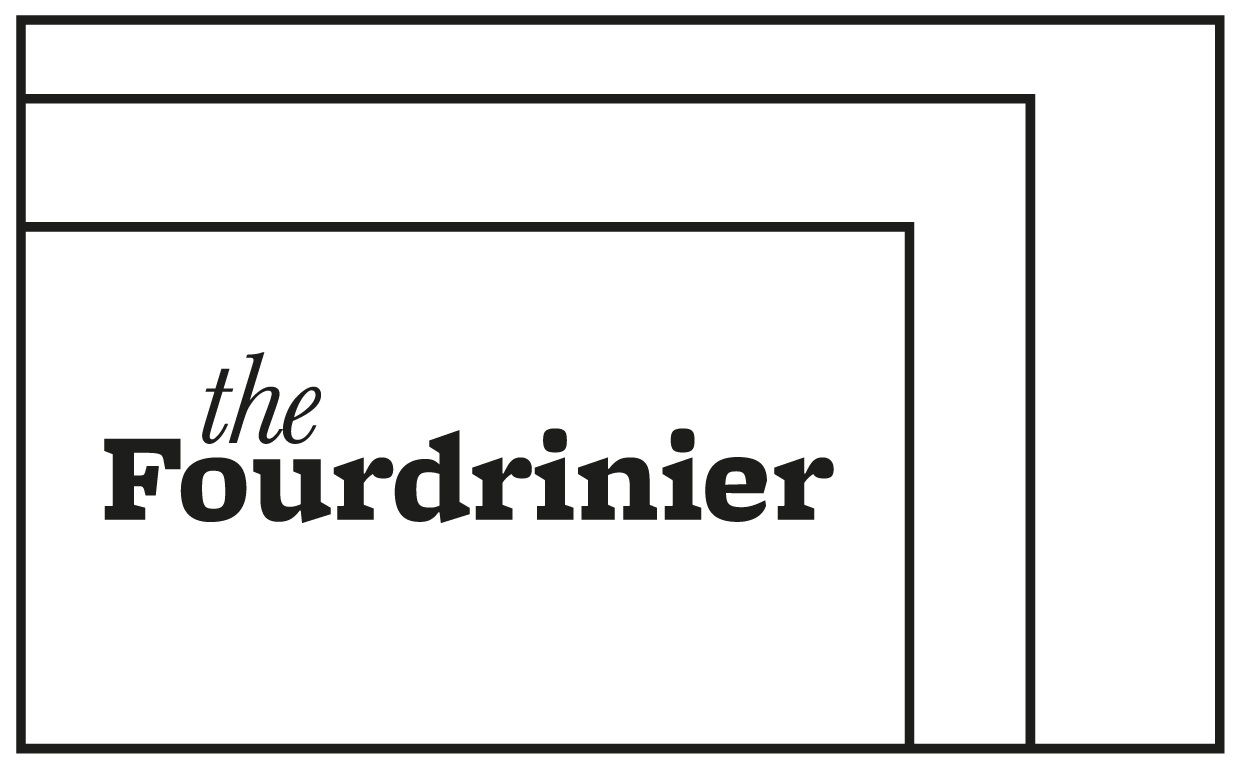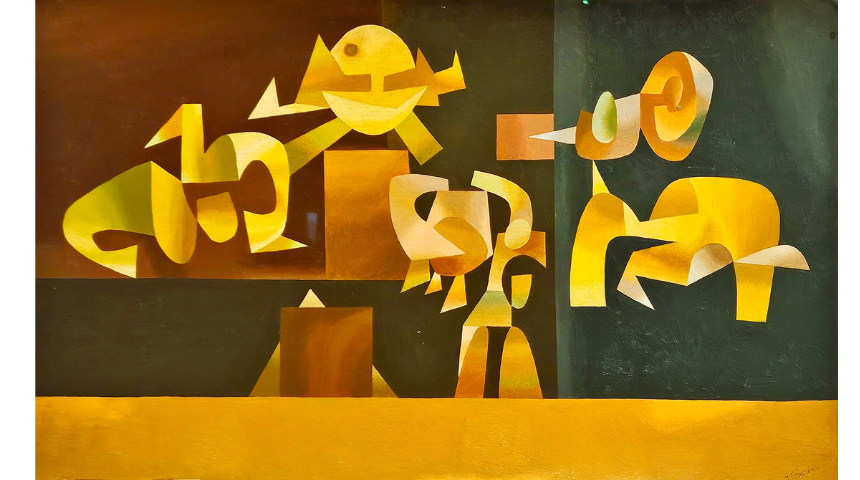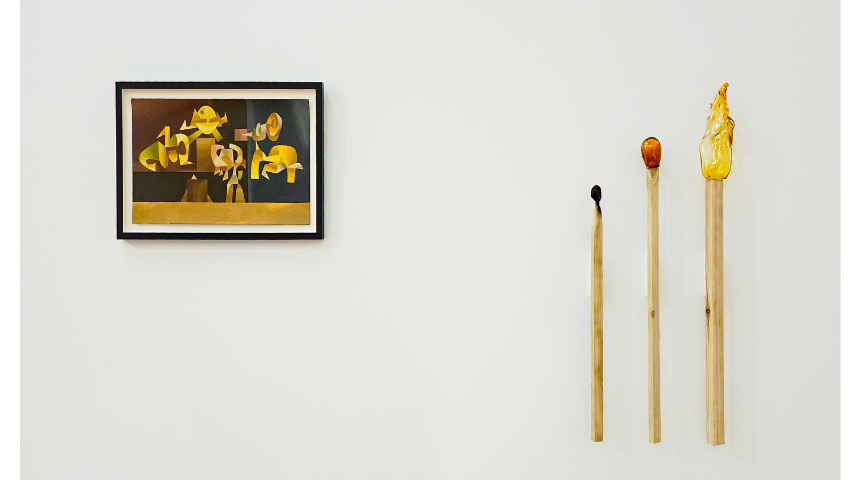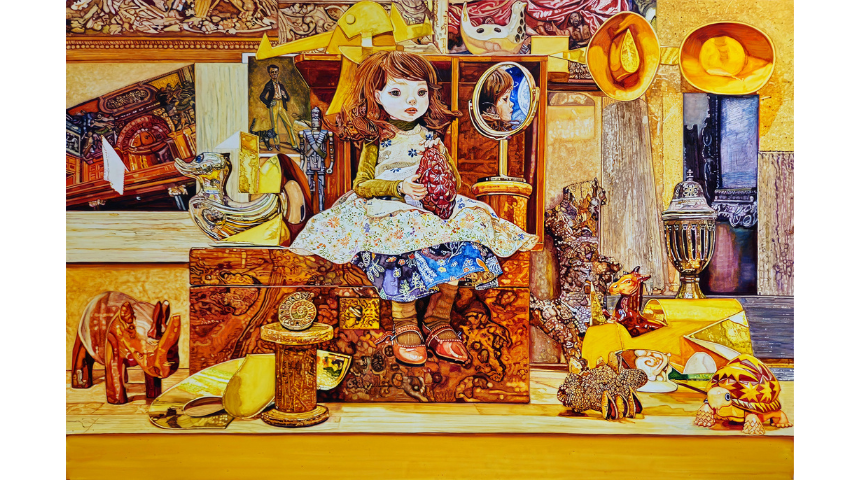FEATURE Jul 2025 To Distant Lands: Remembering Ann Fordham
David Hancock
Ann Fordham Abstraction oil on card 35 x 59cm Salford Museum & Art Gallery Collection
Director of the Fourdrinier, artist, lecturer, and curator, David Hancock remembers the work of the Isle of Man-based painter, Ann Fordham who recently passed away. Hancock included the only known work by Fordham in the exhibition, The Omnipotence of Dream that was presented at Salford Museum & Art Gallery from 19 October 2024 – 23 February 2025.
Yesterday, I received the sad news from the manager of Brookfield Nursing Home in Ramsey, Isle of Man, that the artist Ann Fordham had passed away. She was comfortable and peaceful at the end, having suffered in her later years with dementia.
Ann Christine Fordham was born on 6 April 1933 in Waterberg, Pretoria, to the British farmer William Bruce Fordham and Mary Gertrude Barbour, known as Maidie. A year later, Maidie and William separated, and she returned to England with Ann and her elder brother William Hoy, settling in West Hampstead. Maidie had married William Bruce Fordham in Cape Town, South Africa, in 1931 and returned to the UK with both children, aged one and two, in September 1934, essentially ending their marriage, though they were never formally divorced.
By 1939, Maidie had met the artist Allan Milner, and they were to spend the rest of their lives together, with Allan taking on the role of stepfather to William and Ann. During the Second World War, Allan served in the Royal Navy as a gunner on the Dutch tugs. On several occasions, he sailed through the infamous Torpedo Alley off the coast of North Carolina, where 400 ships were sunk, resulting in the loss of 5,000 lives. After the war, he was introduced to the pivotal figure of British Surrealism, E.L.T. Mesens (1903-71), who in October 1949 offered Milner his first solo exhibition at The London Gallery, a hotbed of Surrealist activity on Brook Street. The famous jazz singer, writer and Surrealism expert George Melly, then working for Mesens, installed the exhibition. Mesens told Milner, “You are the only artist today producing work which I can introduce to the Continent,” and that Milner “is in the forefront with new ideas – themes new to foreign painters.”
On the strength of this relationship, Mesens became Milner’s agent, and in 1949, the family moved to the Isle of Man to start a new life funded by sales of his paintings. Having visited the island as a child, he remembered being so struck by the landscape that he never wanted to go home.
Allan taught Ann to paint. She showed a great deal of ability and first exhibited her work at age 18 in the Second Annual Exhibition of the Mannin Art Group in 1951, showing alongside her stepfather in a room dedicated to his gouache abstracts. For the Fourth Annual Mannin Art Group exhibition in April 1953, Ann turned to the subject of still life. The local art critic in the Ramsey Courier wrote passionately of Ann’s approach during a members-only preview of the July exhibition, “Still life is usually the dullest subject, but Miss Ann Fordham showed us how exciting it can be when in the hands of an artist with imagination and intelligence.” He continued,
“A knowledge of design is necessary before anyone can appreciate the work of Mr Milner and Miss Fordham. The abstract qualities which are supremely important to her painting are here alone expressed. They are none the less emotional for all that; it is a question of what one is emotional about… Although I prefer Miss Fordham's abstract work, and it is interesting to see how personal her expression is becoming, most people will be charmed by her sense of design and colour in her paintings of flowers. Wyndham Lewis said, very wisely, that no one should be allowed to paint from Nature until he or she had attained a mastery of pure abstraction. The wisdom of this is exemplified in Miss Fordham's work.”
The Omnipotence of Dream exhibition installation shot, 2024 photo David Hancock
The favourable comparisons to the work of her step-father evidences the esteem in which she was held upon the island.
In January 1954, at the Mannin Art Group’s Winter Exhibition, Ann presented a single line drawing. The Ramsey Courier noted being “thrilled also by the irresistible logic of Miss Fordham’s line drawing. It was an excellent piece of counterpoint.”
In 1956, Ann was included in the Seventh Annual Mannin Art Group exhibition, showing alongside Allan and William Cosnahan. The Ramsey Courier reported that Albert Frape, Director of Salford Museum & Art Gallery, had been invited to judge the exhibition. He “enjoyed and greatly admired the abstractions in Mr Milner’s room,” and personally congratulated Milner, Miss Fordham and Mr Bealby-Wright. It is likely that one of Ann’s submissions to this exhibition is the work later purchased by Frape and now held in the Salford Museum & Art Gallery’s collection – listed as Abstraction (1956) – the only known surviving work by the artist.
Two years later, in 1958, Ann received a gold star in the Ninth Annual Mannin Art Group exhibition for a work titled T Squared. Its whereabouts are currently unknown. Whether she produced more work, or where those works might be, remains a mystery.
Ann remained living with her mother and Allan Milner until their respective deaths – Maidie in 1976 and Allan in 1984. Allan left her his remaining unsold work, amounting to around seventy pieces. In 2011, Ann donated all but one of these to the Manx Museum in Douglas, Isle of Man. She kept one back to decorate her room at Brookfield. Ann Christine Fordham died on 26 June 2025, aged 92.
My first encounter with Fordham came while planning the exhibition The Omnipotence of Dream, which opened at Salford Museum & Art Gallery in October 2024 – an exhibition that marked the centenary of André Breton’s Manifesto of Surrealism. The exhibition envisioned that a selection of contemporary artists and I would respond to Surrealist works from SMAG’s collection. The Collections Manager, Peter Ogilvie, assembled works from the museum’s holdings that could be considered Surrealist. Among these were four works by a trio of artists from the Isle of Man: Allan Milner, William Cosnahan (real name William Bealby-Wright), and Ann Fordham.
The four works are on card, unframed and around A2 size. None of them had previously been exhibited since entering the collection in 1956. Carefully wrapped in tissue paper, this was opened to reveal a series of striking works, merging Surrealism and Abstraction with startling clarity of vision. Of the four, Ann Fordham’s Abstraction immediately drew my attention. Predominantly gold in colour, it literally glows, as though internally lit. The work is unique and unlike anything I have seen before. Produced by Fordham in her early twenties, it is an incredibly mature piece and, as it stands, a lone example of her talent. The painting, in oil, measures 35 x 59 cm. The bottom quarter of the landscape-oriented work is pure gold in colour. The remaining three-quarters are divided vertically and horizontally: the right third is a dark blue-grey that offsets the warmer tones of the other two-thirds. These are split into horizontal sections, the uppermost being a lighter burnt sienna that takes up the larger portion. Placed within this space is an assortment of abstracted golden forms.
In my own response to the work, a painting I titled To Distant Lands (2024) – a line cribbed from The Stranglers’ 1983 record Golden Brown – I recreated these abstracted forms from gold card, perceiving that Fordham may have done something similar in her process. The forms feel tangible; they possess life and form, congregating around the composition. I saw one as an angel in profile, another as a floating rhinoceros, another a duck, and finally a tortoise. Within my own painting, I found similar objects to make these connections apparent.
David Hancock To Distant Lands (2024) watercolour on paper
The intention of my paintings is to create an uncanny space, enticing the viewer into a world poised between the real and the surreal – a world both tangible and illusory. Positioned centrally in my work, dolls are a recurring motif. I view them as explorations of self, a non-binary avatar aligned to my own personality, tastes, and memories. The doll represents Ann – how I might perceive her – and a manifestation of how I might inhabit her abstracted world, both as the artist and the subject.
Another artist who responded to Fordham’s work in the exhibition was Alana Lake. Born in Staffordshire in 1981, Lake is an artist and researcher whose work bridges art, psychoanalysis, and queer identity. She completed her postgraduate studies at the Royal Academy of Arts Schools, London, in 2009 and is currently undertaking a PhD at Manchester School of Art, titled Towards a Pathology of Desire. Lake adopts an autoethnographic, practice-led approach to investigate the relationship between addiction and desire. From the perspective of a queer female, she uses sculpture and expanded drawing to examine whether addiction is a disease or a biology of desire.
Lake draws parallels between the world today and the one Fordham experienced in the 1950s. Relocated to the Isle of Man at sixteen, Fordham would have struggled to comprehend the aftermath of war, the Holocaust, the atomic age, and the Cold War. Today, we face similar concerns — what Lake refers to as “a multitude of global risks”, from nuclear weapons and climate change to pandemics caused by biotechnology. Lake finds it “striking to observe how the world remains as nonsensical now as it was in the aftermath of a World War.” In response to Fordham’s work, Lake writes:
“Immersed in the observation of abstracted forms suspended in space. Each shape holds its distinct and certain form, yet remains elusive in its identification, maintaining a sense of familiarity. As my eyes navigate through the spatial arrangement, I question whether I am in a room, upon a tabletop, traversing a corridor, or merely encountering blocks of colour.”
Lake’s encounter with Fordham’s work leaves her “disoriented and displaced, yet strangely at ease amidst the queer objects that populate and inhabit the artwork.” She is able to envisage the interconnections between Fordham’s work and her own piece, Your Mouth Lit a Match (2024), which explores fragility and intensity. Lake believes:
“Artists can traverse the darkest recesses of the psyche, shining a light on the irrational forces that drive us. In doing so, they not only make sense of the nonsensical but also challenge viewers to confront their own fears, desires, and insecurities.”
Alana Lake Your Mouth Lit a Match (2024) courtesy the artist
Lake draws similarities between her own work and Fordham’s. She sees the abstracted forms that hover in space as disorienting. There is a displacement between the ambiguously familiar nature of the shapes and the uncertainty of their arrangement. In her response to Fordham, Lake draws out “a queer perspective, inviting the viewer to explore the intersections of fragility, intensity, spatiality, and displacement.”
I hope that more of Ann Fordham’s work will come to light over time, allowing continued exploration of this inspiring artist. In remembering Fordham, we are reminded that even the quietest voices in art history can resonate powerfully across time. Her singular surviving work, Abstraction, offers not only a glimpse into her extraordinary talent but also into a deeply personal vision — one that continues to inspire new interpretations and connections. Though much of her artistic output remains unknown or lost, what endures is the sense of presence and mystery she imbued in her work. Fordham’s legacy lives on in the imaginations of those who encounter her art and in the creative responses it continues to provoke. In the luminous forms she painted, there remains a quiet, enduring light.




